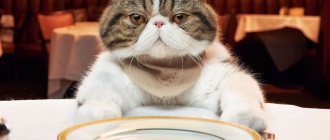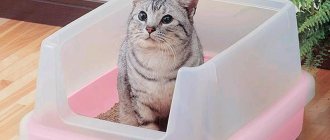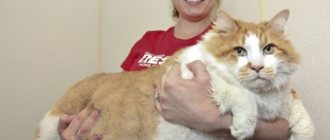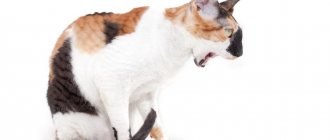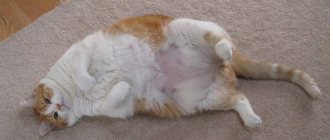If cat owners decide to switch their pets from dry to natural food, this happens most often for the following reasons:
- pet’s health problems requiring refusal of this type of feeding;
- inability to provide high-quality, expensive, premium and super-premium industrial dry products;
- the desire to diversify the menu, maintain health, prolong the life of the cat by feeding natural food, not processed with preservatives.
How to retrain correctly? How to switch a cat to homemade food, because animals are not always ready to share the owner’s intentions and desperately resist innovation, refusing the new diet? Often such voluntary fasting continues for a long time. The cat does not eat, at best it can sniff the food, as a result it loses weight, disturbances in its general condition and behavior appear, and its appearance changes.
Why is it so difficult to wean a cat off ready-made food?
The composition of dry food, especially the line of economy class products, includes a large number of attractants and additives - special ingredients designed to attract the animal, enhance the taste and smell of food, causing persistent addiction to such food. These components are mixed into all feed without exception, especially in super-economy class products. Cats almost immediately become addicted to drugs by eating such food.
The absence of useful components is hidden by manufacturers through the introduction of such chemicals. They significantly worsen the condition of the teeth and fur of pets, cause damage to the psyche, and cause serious illnesses and allergic reactions.
The dangers of dry food
Often the true composition of a product is hidden by the manufacturer. Poor quality food often causes many side effects:
- poisoning with chemicals: dyes and flavors;
- the development of urolithiasis due to an excess of salts as preservatives, especially dangerous for neutered cats;
- the occurrence of vitamin deficiency due to the lack of necessary vitamins and microelements;
- heart failure, allergic reactions;
- Dysbacteriosis is the death of beneficial intestinal microflora, manifested by indigestion, metabolic disorders, skin and coat problems.
What's next?
After your pet has completely switched to a healthy diet, introduce new types of meat. This will help ensure a balance of minerals and vitamins. To calculate your pet's daily intake, you need to take into account its weight, activity level, metabolic rate and other factors. To make it easier for you, we have created a daily value calculator.
You can give your pet treats between feedings. Choose quality treats made from natural products. Such delicacies will be a good addition to the main food and will not disturb the acidic environment of the stomach.
Remember these precautions:
- Wash all surfaces that come into contact with raw food.
- Store raw food separately from other foods.
- After each feeding, wash your pet's bowl with hot water and detergent.
Transferring the cat to homemade food
You can continue to feed the animal its usual food, gradually mixing in various ingredients of another product until a complete replacement occurs. The new type of food should be given to the animal in small quantities in small pieces, no different in size from normal everyday food. After 4-5 days, the volume of dry food is reduced to 50%, then the replacement occurs completely within 10-15 days.
If the pet prefers certain products in addition to dry food, temporarily limit them only to them until the cat is completely weaned from “drying”.
If it is difficult to determine your pet’s taste preferences, it is worth offering several different dishes, placing them in different bowls. The cat will choose and take a liking to the new food, then the cat will be completely switched to homemade food.
There is an option when the volume of regular food is reduced, and the animal, without being completely full, is saturated with another product, homemade, located close to the main, regular food.
Usually, a cat’s refusal of new food plunges the owners into panic - they worry that the pet will become exhausted, get sick, or die. But the animal will not die of hunger if there is food nearby, even if it is tasteless and unloved. Fears are unfounded, remember that you are acting for the benefit of your pet, the cat will humble itself and accept your conditions.
How to switch a cat from dry food to natural food?
Cheers to everyone, my dears! There is a lot of talk about how to organize proper feeding of cats - dry food or natural products?
Dry food is much more convenient for owners, but there are owners who prefer natural food. You can accustom an animal to it even after a long period of feeding with dry food. When planning to switch your cat to a natural diet, remember that the responsibility for its balance falls entirely on your shoulders. Food from the table is not suitable for a cat, no matter how original and funny the animal’s taste preferences in the form of chocolate or fried potatoes may look.
The easiest and safest way to transfer an animal from dry food to natural food is the gradual replacement method. By gradually replacing part of the dry food with natural food, day by day, increasing its share, you will ensure that the cat switches to a completely natural diet. Don't rush, rush is only needed when catching fleas, and not always. After a smooth transition without consequences for the gastrointestinal tract, start feeding your cat correctly and in a balanced manner.
The only problem is that some animals categorically do not want to eat natural products, demonstratively starving for several days. It is highly doubtful that an animal will be able to deliberately starve itself to death, but not every loving owner will be able to withstand such a protest. It often happens that a cat refuses natural food, demanding the usual crackers. The fact is that a pet that has been eating dry food all its life may not understand that there is food in front of it. You'll have to use some tricks to convince him that the meat is edible. For example, you can try sprinkling small pieces of dry food on top of natural food, for example, ground in a meat grinder or coffee grinder, to give the dish a familiar aroma. If your cat experiences digestive problems during the transition from dry food to natural food, consult your veterinarian for advice.
It is always useful to contact a cat nutrition specialist, a veterinary nutritionist, but this is only if you are lucky enough to find one, or a veterinarian if you decide to switch your pet from the usual dry food to natural food. Natural nutrition is eating natural foods, i.e. raw foods, but if you plan to feed your cat thermally processed foods without adding the appropriate supplements of necessary amino acids, minerals and vitamins, you should not waste time and energy, it is better to choose high-quality industrial food that is trusted by the manufacturer! At least everything in it is clear and correctly balanced. In nature, cats eat not just meat, but game, whose body temperature is 37 degrees C and higher. Therefore, it is advisable to warm the cat’s portion to 37-39 degrees before use. Warm food is much better digestible and is more attractive to our gourmets.
If your cat categorically refuses to change its diet, leave it alone. Under no circumstances should cats be allowed to go hungry for more than 2-3 days. If you see that your cat refuses even its favorite food, you need to show it to a veterinarian as soon as possible; in this situation, the option “wait a few days, maybe it will go away on its own” is not acceptable, since such actions can lead to the death of the animal. Prolonged fasting leads to lipidosis (fatty degeneration) of the liver. This is a common liver disease in cats, characterized by infiltration of hepatocytes (liver cells) with triglycerides and neutral fats, leading to bile stagnation (cholestasis) and permanent liver dysfunction. Liver lipidosis is one of the most common lesions of the liver tissue in cats; the disease clinically develops when more than 80% of hepatocytes are affected; the death of the animal can be avoided only with well-organized and timely treatment.
Advice from felinologists
Is it possible to quickly switch a cat to natural food, cat lovers will tell you:
- the addition of catnip facilitates faster adaptation to new food; over time, the supply is stopped, the animal gradually gets used to the food;
- several pieces of dry food are placed on the meat to give it a familiar smell, deceiving the cat;
- probiotics are useful during transition - feeding with dry food worsens peristalsis, lactobacilli improve the digestion process, the microflora is renewed, adaptation is easier;
- during the transition to natural food, vitamins are recommended;
- the bowl of food is removed after 15-20 minutes, regardless of whether there is food left in it or not.
Introduce new food
Introduce new foods gradually. It is easier to switch kittens and puppies to natural food than adult animals. But since the body of kittens and puppies is still developing, it is better to first introduce food from one type of meat. This will ensure that your pet does not have allergies. And if it appears, you will immediately understand what kind of meat the body reacted to. Gradually, you can give food from other types of meat.
The transition will take 10-14 days. The idea is to gradually reduce the proportion of conventional food and increase the proportion of natural food.
- In the first three to four days, the portion should consist of 75% regular food and 25% natural food.
- For the next three to four days, the proportions of both feeds should be equal.
- Then for another three to four days the portion should consist of 25% regular food and 75% natural food.
- After this, you can eliminate regular food.
Scheme of transition to natural food using the example of SUPERPET
How to prepare food
The food should be warm, just like the prey that cats and dogs eat in the wild. Natural food is usually stored frozen. Thaw it in cold water before feeding. This will take about 15 minutes. After this, heat the food in warm water. Remember: food cannot be boiled or heated in the microwave! Food must remain raw. Cooked food loses nutrients and is not suitable for animals.
Good natural foods, including SUPERPET, contain grains of raw bones. Don't worry, they are safe for pets. Bones are a source of calcium and phosphorus. They also help clean plaque from pets’ teeth. If you notice raw bones in the food, do not remove them.
How to help your pet if he doesn't want to try new food?
If your pet refuses to try natural food, try to understand why this is happening.
- Are you unsure of your actions? Animals feel the owner’s uncertainty and therefore may refuse new food. Remember why you decided to switch your pet to a healthy diet? Be more confident, then your pet will feel motivated to try new food.
- Is your pet picky? Some animals are very picky eaters. Don't give up if you don't succeed the first time. Perhaps your cat or dog just doesn't like chicken. That is why SUPERPET starter kits include food from three types of meat.
- Does your pet not understand that it can be eaten? Dogs and cats that ate commercial food were not used to the smell of meat. Flavor enhancers and flavorings are added to industrial feeds to stimulate the appetite of animals. Perhaps your pet simply does not understand that this new thing in the bowl is food. Try feeding your pet by hand. When he decides to try the food, praise him: the pet will understand that he is doing everything right and will no longer need to feed him by hand.
Home feeding diet
The main product in this type of diet is meat, about 80%. The rest is cereals, vitamins, vegetable supplements. Natural feeding requires an accurate calculation of the daily food intake; the idea that the cat itself knows how much it needs to eat is wrong. Often, fluffy beauties, without knowing the limits, gobbling up delicious foods on both cheeks, acquire excess weight, heart and respiratory problems. Different ages are taken into account when compiling the daily menu.
How to calculate a kitten's nutritional intake
Two and a half months is the age at which a baby can be separated from its mother. Before nine months, the kitten should receive no more than 10% of its weight in food. With a weight of 2000 g, the weight of the daily portion is 200 g. 50% is meat food, 50% is fish products.
How to calculate the amount of food per day for an adult cat
An adult animal needs only 5% of its weight in feed. With an animal weighing 5 kg - 250 g of natural food, consisting of equal parts of fermented milk and meat products. 20 g of vegetables and a few drops of vegetable oil are allowed. Active pets, who expend a lot of energy, are given more food, inactive, obese, and elderly pets require less.
What can you give your cat?
The main components of natural cat food are:
- fish is a favorite product of fluffy beauties; marine varieties are recommended, both raw and boiled. Boiled fish should be cleaned of bones; they can be easily separated from the pulp; they can be swallowed unchewed or get stuck in the esophagus;
- meat - lean chicken, beef, lamb, rabbit, horse meat, scalded with boiling water, are allowed. Pork is banned;
- by-products - liver, lungs, heart, kidneys - are introduced into the diet 2 times a week - their nutritional value and usefulness are low. If there are signs of poor digestion: vomiting, diarrhea, by-products are excluded from the animal’s menu;
- fermented milk products - kefir, cottage cheese, medium-fat starters. Low-fat foods cause stool upset. Cats do not tolerate milk well - the number of enzymes that break down lactose decreases with age;
- vegetables - any are allowed: cabbage, carrots, peppers, pumpkin. A combination is possible. They are given in crushed raw form and can be mixed with meat. Potatoes - excluded;
- eggs - chicken or quail are suitable. The yolk and white are mixed. Serve separately or with kefir and cottage cheese.
A pet’s illness or surgery is a reason to contact a veterinarian to correct the animal’s nutrition.
Chicken necks have proven themselves well for natural feeding of cats. They are prepared as follows: mince twice through a meat grinder to grind hard bones, add a little boiled rice or buckwheat, and grated carrots. They mix.
Natural food is natural healthy nutrition for your feline. With good care, a kind attitude, a positive attitude of the owners, and a well-designed feeding diet, the animal will be healthy, happy, and will live a long, fulfilling life next to its owners.
